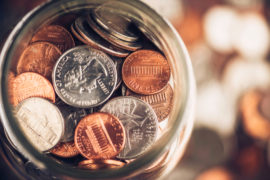Last Updated on Jan 21, 2023 by James W
Has the coronavirus pandemic changed the way you view your money? Whether you lost your job or you were forced to save more of your income, chances are the COVID-19 public health crisis made you adjust your perspective on all things finance.
A recent survey found that 60% of Americans say the pandemic forever changed how they budget and spend their money. They spent fewer dollars on a broad array of goods – from luxury goods to apparel – and more than half reported reallocating their “going out” budget for staying in. But they also suffered a “significant” financial setback, slashed their budgets, and experienced new unexpected expenses.
Ultimately, the pandemic forced millions of people to start taking their finances seriously. Will everyone stick to their saving and investing goals on the other side of this unprecedented event?
The best way to reach long-term goals is through adopting some effective money growth strategies. Unsure where to begin? Check out our guide on key investing and saving steps with the best investment app that everyone should take – the sooner the better!
1. Pay Yourself First
The key to saving is to pay yourself first, no matter how much or often. Whenever you receive a paycheck or a tax refund, the first thing to do is transfer a portion – $25 or 5% – to your savings account. Even if you have debt you want to wipe out, those savings can go a long way to achieving your primary objective.
We all lead busy lives, and it is hard to remember. So, the simple solution is to sign up for an automatic savings program (ASP) offered through your financial institution, which automatically transfers a portion of money from your chequing account on a regular basis, into somewhere where it has the opportunity to grow. You can pick the amount and the frequency to accommodate your finances. If you want to go one step further, you can automate your investing using an all-in-one checking and investment account.
Set it and forget it; the easiest route to getting your money to work harder for you.
2. Create an Emergency Fund
An emergency fund is critical. Be it a broken-down refrigerator or a wisdom tooth that needs to be pulled, an emergency fund can help to cover the cost, so you do not need to tap, swipe, or insert a credit card. Most importantly, an emergency fund exists so you do not need to rely on your savings or investments to pay these unforeseen circumstances.
Remember, your savings account – retirement or otherwise – is designated for a specific aim. Sticking to this target (rather than spending these funds on unexpected emergency expenses) is the only way to maximize growth.
3. List Your Savings Goals
So, what do you wish to achieve with your savings goals? Do you have short- and long-term aims? Or is your high-interest savings account strictly for your golden years?
Whatever your personal situation may be, it is wise to separate your capital into short- and long-term goals. For example, a short-term goal might be a vacation to Venice or Paris, and a long-term objective could be your child’s college education. This way, you can keep track of every dollar and cent you set aside for the future.
4. Change the Way You Spend
The best way to save is to change the way you spend. Most financial experts express the importance of having a budget and sticking to it. But you can also employ other measures to ensure that you monitor your pennies, and you keep more of the fruits of your labor rather than tossing it down the drain.
Unsure where to begin? Here are some tips to consider by changing your spending habits to save more:
- Cancel automatic subscriptions and memberships you rarely use, such as gym memberships and streaming services.
- Eliminate your cable package and rely on the internet for content consumption.
- Purchase generic brands at the grocery store.
- Take advantage of coupons and discounts.
- Cut down on your energy costs by reducing the heat (wear a sweater), taking shorter showers, and installing LED lightbulbs.
- Engage in price comparison for everything, from your cellphone bill to your insurance rates.
- Sell everything that you do not need or no longer sparks joy.
Remember that the smallest changes can make a big impact over time. Start by skipping the coffee shop and brew your morning java at home. Your dark roast or latte ritual can cost you a few bucks each trip, but a cup made at home costs you pennies, and over time, those savings add up!
5. Invest Long-Term
If you have been scanning the business headlines as of late, you may have read about GameStop, AMC, and Nokia shares skyrocketing over a short period. This may have left you lamenting “if only I had bought shares.”
That said, when you invest, you should only invest for the long-term: 10, 20, or 30 years. You’ll always experience peaks and valleys, but if you buy a good stock, you will ultimately end up with higher gains by the time you hit the sell button in the next couple of decades.
Also, dollar cost average (DCA) your way to investment success, which allows you to evade volatility and generally reduce your share price average over time.
6. Focus on Dividend Investing
Are you getting paid for holding a stock? That is what dividend investing is all about. In an era of historically low interest rates, parking most of your net worth in a savings account becomes dead money. If you are receiving pennies on hundreds or thousands of dollars, why bother?
While it is a good idea always to have money in a savings account, you should also buy dividend-paying stocks to generate income. A dividend is a profit paid out by the company every quarter. For example, Walmart pays its investors 55 cents per share every quarter, while Chevron offers its shareholders $1.29 for each share they own.
Over time, this money adds up. You have two options: reinvest the dividends or transfer them into your savings account.
If you need some inspiration for dividend stocks, here are some investment picks:
- Restaurant Brands International (QSR): 2.77%
- World Wrestling Entertainment (WWE): 0.88%
- TD Bank (TD): 3.85%
- CubeSmart (CUBE): 3.60%
- Coca-Cola Co (KO): 3.19%
7. Index Your Investments
Who has time to watch CNBC or monitor Yahoo! Finance all day long? Since you probably lack the time and patience to scan stock tickers during every trading session, you might as well index your investments.
An index fund is an investment that mirrors the composition and performance of a broader market index, such as the S&P 500 or the Nasdaq Composite Index. This is achieved through mutual funds and exchange-traded funds (ETFs). Research has found that index investing can offer you greater returns at a lower cost than individual stock picking. Plus, dividends are historically safer with indexes.
8. Use Roth IRAs for Your Investing Needs
Investing can be exciting, especially when your portfolio is headed to the moon. Unfortunately, eventually the taxman will rear his ugly head and start eating away at your profits.
This is why a Roth individual retirement account (IRA) is necessary since it offers tax-free growth and tax-free withdrawals in your retirement. Note that in order to withdraw your money from a Roth IRA, you need to have owned the account for at least five years and be at least 59 ½ years of age.
Let’s be honest: we have done a terrible job when it comes to saving our hard-earned money. Until the pandemic struck, the personal savings rate nationwide was a paltry 3% to 5%. Today, many households are saving greater portions of their paychecks. But where are they putting this newfound cash? And can they sustain the momentum? By embracing these tips, you can guarantee that you will come out of the pandemic more financially savvy than you could ever imagine.



